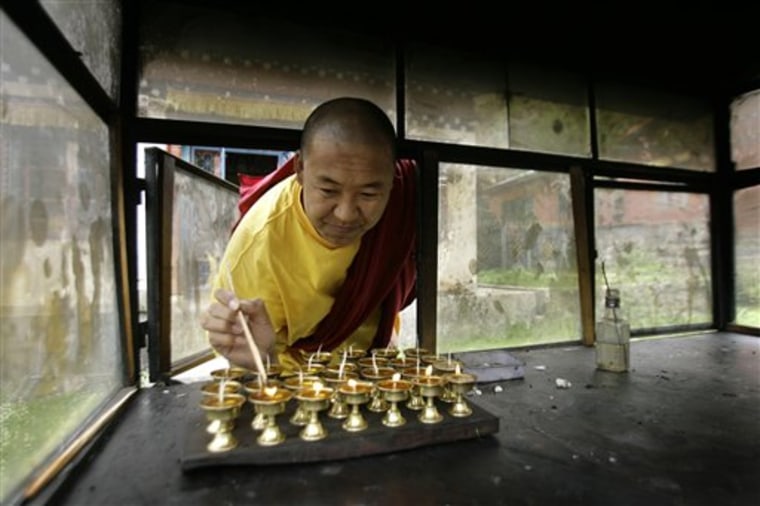Three lithe Chinese security men shift silently into position so they are anchored abreast exactly midway across Friendship Bridge, high above a Himalayan river gorge.
It's the only international gateway into Tibet. As a small group of foreigners approaches, the guards' unspoken message is clear: the rebellious territory behind them is off-limits.
After anti-government riots erupted March 14, Beijing closed off Tibet to foreign and domestic tourists and cracked down on Tibetans trying to escape. And China's security apparatus doesn't stop at the border.
Chinese security police in athletic wear can be seen lounging in tea shops and strolling the sole street in the border town of Liping. They shadow three Associated Press journalists from the moment they arrive, ordering them not to take photographs — on Nepalese territory.
And in the capital Katmandu, Tibetan exiles say China is pressuring the Nepalese government to crush anti-Chinese activities by the world's second-largest Tibetan exile community.
"The Chinese asked us unofficially to cooperate on securing the border. They are far stricter now," said one Nepali immigration official, requesting anonymity since he was not authorized to speak to the press. "Even an Austrian lady who was studying Chinese in Lhasa (Tibet's capital) was not allowed to enter."
Before the current unrest, some 1,500 foreigners a month would make the rough, four-hour car journey on a Chinese-built road from Katmandu to the border and then on to Lhasa.
No tourism allowed
Now, Chinese authorities have reversed an earlier decision to reopen Tibet to tourism on May 1, tour operators in Beijing said last week. There has been no official indication of when the border would reopen. The International Campaign for Tibet, a U.S.-based activist group, says it has information the region may remain sealed until after the Beijing Olympics in August.
"This is the high season, so we should be getting a full house, but we have very few guests," said Pabitra Mager, a manager at Liping's Lhasa Guest House. "We can only hope that the border will reopen soon."
Officials in Beijing also have declined to comment on troop deployments. But Nepalese frontier officials say there has been a significant increase in border patrols. A woman who answered the telephone at the Public Security Bureau in Zhang Mu, the Tibetan town opposite Liping, also said that more police and troops have been dispatched to the region. She declined to give her name.
The buildup also means no exit from Tibet. No refugees have registered at the U.N.-run Tibetan Reception Center in Katmandu since March 18. A spokesman of the U.N. High Commissioner for Refugees, Nini Gurung, said normally 200-250 flee into Nepal each month, discounting winter snows still on the mountains as a major factor for the dramatic drop.
Refugees avoid the well guarded Friendship Bridge zone, braving instead some of the world's most treacherous terrain — mountain passes as high as 16,400 feet often swept by sudden snow storms — along the 878-mile border.
Guarding the border
In the past, some have been gunned down by Chinese guards or sentenced to long jail terms after capture. A few have been abused and forcibly repatriated by the Nepalese, despite a 1989 "gentlemen's agreement" with the U.N. High Commissioner for Refugees.
The pact allows refugees to remain in Nepal while they are processed by the agency. Then they are sent to India, home of the world's largest Tibetan exile community and its spiritual leader, the Dalai Lama.
China has provided substantial development aid to Nepal over the past decade, increasing its leverage. Activists say China could pressure Nepal to crack down on some 6,000 among the 20,000 Tibetan exiles without legal status in Nepal and go after exile groups which stage almost daily anti-Chinese protests in Katmandu.
Under pressure from Beijing, Nepal closed the representative office of the Dalai Lama in 2005 and last year deregistered the Bhota Welfare Office, a local organization assisting Tibetans.
"China already had a very heavy footprint in Nepal and after the protests it will get even bigger, making the Tibetan refugees very vulnerable," says Kate Saunders of the International Campaign for Tibet.
'Free rein in Katmandu'?
Saunders said Chinese security officials have been right behind Nepali riot police and have directed suppression of protests. "China has been given a free rein in Katmandu," she said.
Local journalists covering the demonstrations have also seen Chinese personnel, although no indication they were issuing instructions to police.
Home Ministry spokesman Modraj Dotel denied Chinese security gives the orders, saying the protests violate Nepal's rules. "We have a one-China policy and won't allow any protests or activities against China in Nepal," he said.
Nepalis, meanwhile, have been partially exempt from the frontier clampdown. Visas for businessmen going to Lhasa are still granted and cross-border business continues. Traders cross the bridge on foot or in trucks, hauling in apples, Lhasa beer, perfumed laundry powder, wool blankets, rice cookers and mobile telephones. ("Very cheap, but they only last two months," jokes a Nepali woman in Liping).
